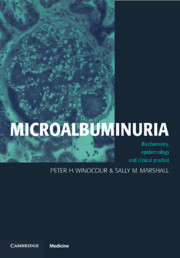Book contents
- Frontmatter
- Contents
- Preface
- Foreword by Professor K. G. M. M. Alberti
- 1 Renal structure and physiology
- 2 Measurement and expression of microalbuminuria
- 3 Epidemiology and determinants of microalbuminuria in health
- 4 Microalbuminuria in diabetes mellitus
- 5 Microalbuminuria as a marker of endothelial dysfunction
- 6 Microalbuminuria, cardiovascular risk factors and cardiovascular disease
- 7 Microalbuminuria as a non-specific marker of disease
- 8 The management of microalbuminuria in diabetes mellitus and essential hypertension
- Index
5 - Microalbuminuria as a marker of endothelial dysfunction
Published online by Cambridge University Press: 06 July 2010
- Frontmatter
- Contents
- Preface
- Foreword by Professor K. G. M. M. Alberti
- 1 Renal structure and physiology
- 2 Measurement and expression of microalbuminuria
- 3 Epidemiology and determinants of microalbuminuria in health
- 4 Microalbuminuria in diabetes mellitus
- 5 Microalbuminuria as a marker of endothelial dysfunction
- 6 Microalbuminuria, cardiovascular risk factors and cardiovascular disease
- 7 Microalbuminuria as a non-specific marker of disease
- 8 The management of microalbuminuria in diabetes mellitus and essential hypertension
- Index
Summary
The relationship between microalbuminuria and cardiovascular disease will be dealt with at length in Chapter 6, but one compelling view is that glomerular dysfunction leading to microalbuminuria may reflect a more widespread dysfunction of all vascular endothelium. Before discussing the evidence for, and the difficulties with this hypothesis, it is important to consider the intricate nature of normal vascular endothelial cell function.
The vascular endothelium may be regarded as a complex regulatory ‘organ system’ with endocrine, paracrine and autocrine function. It is closely integrated with underlying structures, which themselves may vary in their composition and function in different organ systems, for example between the retina and the glomerulus. This concept of local variation in function is further demonstrated by experimental evidence of endothelial function operating within a ‘microenvironment’, by which focal regulatory function in response to a given stimulus takes place within a limited area of the vascular bed. This immediately highlights the difficulty of extrapolating information on endothelial function from, for example, the systemic to the coronary, or from the venous to the arterial circulation, or from large arteries to arterioles.
Furthermore endothelial function differs between the venous and arterial components of the circulation, and drawing parallels between in vitro and in vivo findings may be quite inappropriate. Many in vivo studies to date have been cross-sectional in nature, and thus have been limited in their ability to define pathophysiology.
- Type
- Chapter
- Information
- MicroalbuminuriaBiochemistry, Epidemiology and Clinical Practice, pp. 97 - 115Publisher: Cambridge University PressPrint publication year: 1998



